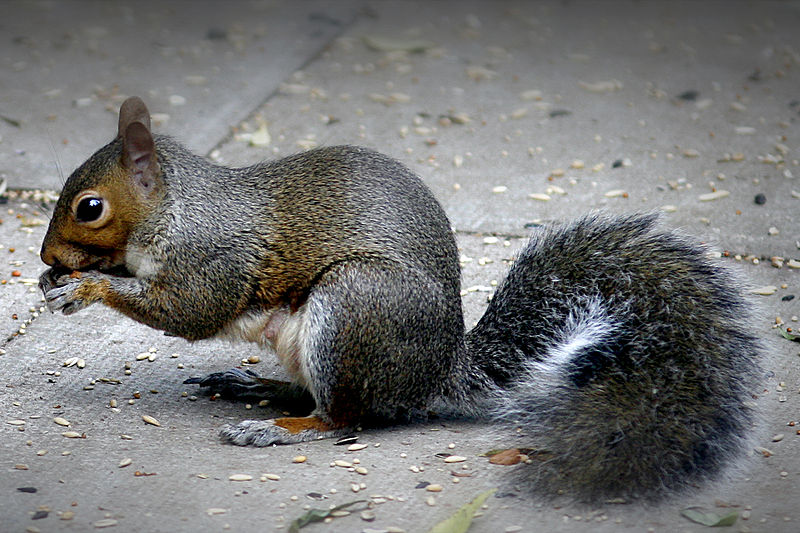Yes, squirrels can spread certain diseases to humans and pets, but the risk is generally low with proper precautions.
Picture this It’s a sunny Saturday afternoon, and you’re enjoying a peaceful moment in your backyard. Birds are chirping, the breeze is gentle, and suddenly, you spot a squirrel darting across the lawn. It’s a common sight, one that usually brings a smile to your face. But as cute as these little critters are, there’s a question lingering in the back of your mind: Do squirrels spread disease?
Let’s face it, we’ve all been there. Whether it’s watching them scamper up trees or sneak a snack from the bird feeder, squirrels are an inevitable part of outdoor life. While they often seem harmless, there’s more to these furry friends than meets the eye. Yes, squirrels can spread certain diseases, and it’s important to understand what those are and how to protect yourself and your pets.
Key Takeaways
- Squirrels can carry and transmit certain diseases.
- Most squirrel-related diseases are rare but can be serious.
- Understanding how diseases are spread helps in prevention.
- Simple precautions can significantly reduce the risk of disease transmission.
Understanding Squirrel Behavior
Alright, let’s dive into the world of our bushy-tailed neighbors! Squirrels are more than just cute little creatures scampering around your yard; they have some fascinating behaviors that might surprise you.
A Day in the Life of a Squirrel
Ever wondered what squirrels do all day? Well, they’re busy little acrobats! From sunrise to sunset, squirrels are out and about, foraging for food, burying nuts, and maintaining their nests, known as dreys. These nests are typically found high up in trees, constructed from twigs, leaves, and whatever soft materials they can find. When winter comes, these dreys become their cozy havens against the cold.
Why They Might Be Visiting Your Property
So why do squirrels love your yard so much? The answer is simple: food and shelter. Squirrels are always on the lookout for their next meal. Your bird feeder, garden, or even your trash can become their buffet. And those towering trees or attic spaces? Perfect spots for nesting! Squirrels are opportunistic and will take advantage of any easy access to food and shelter.
The Social Life of Squirrels
Despite their solitary nature when it comes to feeding, squirrels are quite the social butterflies within their own family units. You might spot them chasing each other around in playful games, especially during the mating season. And speaking of family, female squirrels are fiercely protective of their young, often relocating their babies if they sense danger.
Interaction with Humans and Other Animals
Squirrels are naturally curious but can be skittish around humans. However, in areas where they’ve become accustomed to people, they might venture closer, sometimes even taking food from your hand (not recommended, by the way – we’ll get to why later!). When it comes to other animals, squirrels are pretty savvy. They have a unique alarm call to warn each other of predators like hawks, cats, or dogs, demonstrating their strong survival instincts.

Common Diseases Spread by Squirrels
Alright, it’s time to get into the serious stuff – the potential health risks associated with our furry friends. While it’s not common, squirrels can carry and transmit certain diseases. Let’s break down the ones you should be aware of.
Leptospirosis
Leptospirosis is a bacterial disease that can affect both humans and animals. It’s typically spread through contact with the urine of infected animals, which can contaminate water or soil. If you have a curious pup that enjoys sniffing around where squirrels frequent, or if you handle materials where squirrels have been, there’s a slight risk of contracting this disease. Symptoms in humans can range from mild flu-like signs to severe complications, so it’s always good to be cautious.
Salmonella
You might be more familiar with salmonella as a foodborne illness, but it can also be spread by squirrels. These little critters can carry salmonella bacteria in their feces. If they’ve been in your attic or around your home, and you come into contact with contaminated surfaces, you could be at risk. Symptoms typically include diarrhea, fever, and abdominal cramps. Proper hygiene and cleanliness can significantly reduce this risk.
Lyme Disease
This one might surprise you – while squirrels themselves are not the primary carriers of Lyme disease, they can host the ticks that spread it. Lyme disease is caused by the bacteria Borrelia burgdorferi, which is transmitted to humans through the bite of infected black-legged ticks (also known as deer ticks). If squirrels are frequent visitors to your yard, there’s a chance they could be transporting these ticks closer to you. Symptoms of Lyme disease include a characteristic rash, fever, headache, and fatigue.
Tularemia
Tularemia, also known as “rabbit fever,” is a rare but serious infectious disease caused by the bacterium Francisella tularensis. Squirrels can be carriers, and humans can contract it through direct contact with an infected animal, insect bites, or even inhaling contaminated dust. Symptoms vary widely but can include skin ulcers, fever, and swollen lymph glands. It’s a rare condition, but worth being aware of if you’re handling squirrels or their nesting materials.
Plague
Yes, the plague still exists, and squirrels can be carriers! The bacterium Yersinia pestis, responsible for the plague, is primarily spread by fleas that infest rodents, including squirrels. While it’s extremely rare in modern times, cases do still occur, mostly in rural areas. The symptoms can range from swollen lymph nodes to severe respiratory issues. The risk is minimal, but it’s a reminder of why pest control and hygiene are so important.
How Common Are These Diseases?
Before you panic, it’s important to note that while squirrels can carry these diseases, the likelihood of transmission to humans is relatively low. Most cases occur under specific conditions, such as handling an infected squirrel or coming into direct contact with their waste. Nevertheless, being aware of these diseases helps you take proper precautions to protect yourself and your family.
Understanding the potential health risks associated with squirrels is the first step in keeping your home safe. Next, we’ll dive into how common these transmissions are and what steps you can take to minimize the risks even further. Keep reading for some practical tips and insights!
Factors Affecting Disease Transmission
Alright, let’s get down to the nitty-gritty of how these bushy-tailed critters might pass on some unwanted souvenirs. Trust me, it’s not as straightforward as you might think!
First off, let’s talk about direct contact. Now, I know what you’re thinking – “Who in their right mind is out there cuddling with squirrels?” Well, you’d be surprised! Whether it’s well-meaning folks trying to help an injured squirrel or those misguided souls attempting to make the next viral TikTok video, direct contact happens more often than you’d expect. This is your prime opportunity for disease transmission, folks. Bites, scratches, or even just handling a squirrel can potentially expose you to whatever nasties they might be carrying.
But here’s the kicker – you don’t even need to touch a squirrel to potentially catch something. Indirect contact is sneakier and, frankly, more common. Ever had a squirrel raid your bird feeder? Or maybe you’ve found their little “gifts” in your yard? Yep, that’s indirect contact right there. Diseases can spread through their droppings, urine, or saliva left on objects in your environment.
Now, let’s give a not-so-warm welcome to the real villains of our story: ticks and fleas. These little bloodsuckers are the ultimate double agents. They feast on infected squirrels, then hop off to find their next meal – which could be you or your pets. Lyme disease, for instance, is primarily spread this way. So while you’re busy watching that adorable squirrel scamper across your lawn, a tick might be using it as an Uber to get to you.
But wait, there’s more! Environmental factors play a huge role too. Wet, warm conditions? That’s a theme park for bacteria like leptospirosis. Drought causing squirrels to seek water sources closer to human habitation? Hello, increased chance of contact. Climate change is shaking things up, folks, and not in a good way.
And let’s not forget about population density. The more squirrels squeezed into an area, the higher the chances of disease spread among them – and potentially to us.
So, there you have it – the full scoop on how these cute little furballs might be secret disease couriers. But don’t panic just yet! Remember, knowledge is power. Now that you know the factors at play, you’re better equipped to keep yourself safe while still appreciating our squirrely neighbors from a distance.
Assessing the Risk: Should You Be Worried?
Alright, let’s take a deep breath and put on our rational thinking caps. We’ve talked about diseases and transmission factors, and I can almost hear some of you reaching for hazmat suits. But before you go full doomsday prepper on me, let’s put this squirrel situation into perspective.
First things first: Yes, squirrels can carry diseases. But here’s the kicker – the risk of actually contracting a disease from a squirrel is pretty low. I’m talking “winning-the-lottery-while-being-struck-by-lightning” kind of low. Okay, maybe not that low, but you get the idea.
Think about it – how many times have you seen a squirrel in your life? Now, how many times have you caught a disease from one? I’m willing to bet the answer to the second question is a big fat zero for most of you. And if it’s not, well, you might want to reconsider your squirrel-cuddling hobby.
Let’s put this in perspective with some other wildlife-borne disease risks:
- Mosquitoes: These tiny terrors are responsible for hundreds of thousands of deaths globally each year. Malaria, Zika, West Nile – the list goes on. Suddenly, squirrels aren’t looking so scary, are they?
- Ticks: While squirrels can carry ticks that spread Lyme disease, you’re much more likely to pick up a tick from tall grass or wooded areas than from a squirrel directly.
- Raccoons: These masked bandits are more likely to carry rabies than squirrels and are often more willing to interact with humans and our trash.
- Bats: Another rabies risk, plus they can spread histoplasmosis through their droppings.
So, where do squirrels rank on this list? Pretty low, my friends. They’re more likely to raid your bird feeder than give you a life-threatening illness.
But here’s the thing – I’m not saying you should throw caution to the wind and start a squirrel petting zoo in your backyard. The risk might be low, but it’s not zero. It’s all about smart coexistence.
Think of it like driving a car. Is there a risk? Sure. But do you never leave your house because of it? Of course not. You take precautions – you wear a seatbelt, obey traffic laws, and stay alert. Same deal with squirrels. A little common sense goes a long way.
So, should you be worried? Not excessively, no. But should you be aware and take basic precautions? Absolutely. It’s all about finding that sweet spot between paranoia and recklessness.
Prevention and Safety Measures
Alright, nature lovers, it’s time for the good stuff – how to keep yourself safe while still enjoying our bushy-tailed neighbors. Don’t worry, I won’t be recommending any squirrel-proof bunkers or acorn-detecting alarms. These tips are all about practical, common-sense measures that’ll let you coexist peacefully with our furry friends.
Keep your distance
I know, I know, they’re adorable. But remember, squirrels are wild animals, not plush toys. Admire them from afar, like that crush you had in high school. A good rule of thumb? If you can reach out and touch a squirrel, you’re too close. Back it up, buddy!
Don’t feed the wildlife
I get it, tossing peanuts to squirrels seems harmless. But it’s like giving sugar to a toddler – it only encourages bad behavior. Plus, it brings them closer to you, increasing the risk of disease transmission. Let them forage naturally; they’re pretty good at it.
Seal up your home
Think of your house as a fortress against the squirrel army. Check for and seal any potential entry points. This isn’t just about disease prevention – it’s also about avoiding a surprise squirrel roommate. Trust me, they make terrible tenants.
Keep your yard tidy
Fallen fruit, open trash cans, or unsecured compost bins are like an all-you-can-eat buffet for squirrels. Clean up regularly to avoid attracting them too close to your living space.
Use gloves when gardening
You never know what a squirrel might have left behind in your flowerbeds. Gloves protect you from potential pathogens in soil or on plants that squirrels may have contaminated.
Protect your pets
Keep your furry family members up to date on their vaccinations, especially for diseases like leptospirosis. And maybe reconsider letting Fluffy roam free if you have a high squirrel population in your area.
Practice good hygiene
Wash your hands thoroughly after being outdoors, especially before eating. It’s not just for squirrel safety – it’s good practice in general. Your immune system will thank you.
Know when to call for help
If you find an injured or sick squirrel, resist the urge to channel your inner Snow White. Contact a local wildlife rehabilitator instead. They’re trained to handle these situations safely.
Be tick aware
Since ticks are a major disease vector, check yourself and your pets for ticks after spending time outdoors, especially in wooded areas.
Educate yourself and others
Knowledge is power, folks. The more you understand about squirrels and their behavior, the better equipped you’ll be to coexist safely.
Myths and Misconceptions
Alright, folks, it’s time to play a little game I like to call “Squirrel Fact or Squirrel Fiction?” We’re about to bust some myths wider than a squirrel’s cheeks stuffed with acorns. So, grab your nutcracker of truth, and let’s get cracking!
Myth #1: All squirrels carry diseases
Fiction! While it’s true that squirrels can carry diseases, not every squirrel is a walking petri dish. Many squirrels are perfectly healthy. It’s like assuming every human you meet has the flu – possible, but not probable.
Myth #2: If a squirrel bites you, you’ll definitely get rabies
Fiction with a capital F! Squirrels rarely carry rabies. In fact, small rodents (like squirrels, rats, and chipmunks) are almost never found to be infected with rabies and have not been known to transmit rabies to humans. That said, if you get bitten, clean the wound and see a doctor anyway. Better safe than sorry!
Myth #3: Squirrels spread diseases by dropping acorns on people
I can’t believe I have to say this, but… fiction! This isn’t some cartoon where squirrels are secretly plotting our demise via acorn bombardment. Diseases spread through more direct means, like bites or contact with bodily fluids. The acorns are just collateral damage in their never-ending quest for snacks.
Myth #4: You can’t get sick from squirrels if you don’t touch them
Sorry, but this one’s fiction too. While direct contact is riskier, remember our chat about indirect transmission? Contaminated surfaces or tick bites can spread diseases without you ever laying a finger on a squirrel.
Myth #5: Feeding squirrels bread is a good way to keep them healthy and disease-free
Fiction! Bread isn’t a natural part of a squirrel’s diet and doesn’t provide the nutrients they need. Plus, regular feeding encourages them to rely on humans, bringing them closer to us and potentially increasing disease transmission risks. Let them stick to their nuts and berries – they’ve been managing just fine for millions of years.
Myth #6: If you see a squirrel active during the day, it must be rabid
Fiction! Squirrels are diurnal creatures, meaning they’re naturally active during the day. A nighttime squirrel sighting would be more unusual (though still not necessarily a sign of rabies).
Myth #7: Squirrels remember humans who feed them and won’t transmit diseases to their “friends”
Oh, bless your heart if you believed this one. It’s fiction, folks. Squirrels don’t have a “nice human” list they check before deciding whether to transmit a disease. They’re wild animals, not your secret woodland BFFs.
Myth #8: City squirrels carry more diseases than country squirrels
This one’s tricky, but generally fiction. While urban environments can create different health challenges for squirrels, rural squirrels have their own set of potential pathogens. Neither is inherently “dirtier” than the other.














